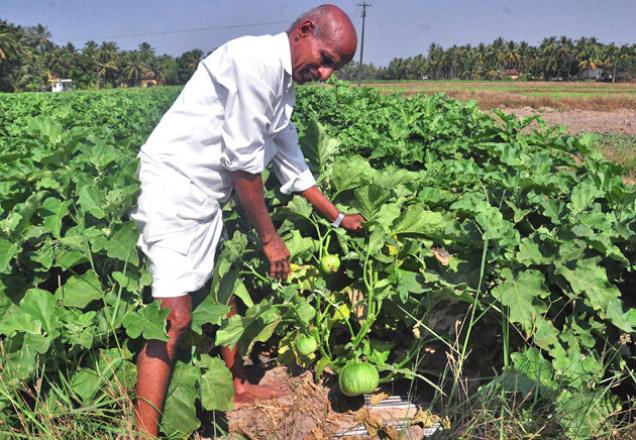 For most of the farmers, the new method of cultivating Mattu gulla, introduced a couple of years ago, has come as a blessing and increased their yield.
For most of the farmers, the new method of cultivating Mattu gulla, introduced a couple of years ago, has come as a blessing and increased their yield.
The Mattu gulla, a brinjal unique to Mattu and its surrounding villages that enjoys the Geographical Indication (GI) tag, is much sought-after as its taste is different from other brinjals. Nearly 200 farmers grow this brinjal on about 150 acres of land in Mattu, Kopla, Kaipunjal, Uliyargoli and Pangala villages.
The Mattu gulla is a seasonable vegetable, available till the month of June or the outbreak of monsoon. After the monsoon, the farmers normally grow paddy on the same land.
A team of presspersons were taken by the Department of Information from Udupi to Mattu to show the benefits of the new method of cultivation.
In the traditional method of cultivation, the seeds are sown directly in the soil and watered in the conventional method.
Method
The new method of cultivation involves growing the saplings in pro-tray in a net house and then planting them in soil covered with a plastic mulch sheet and watering them through drip irrigation.
Sadashiva Rao, Senior Assistant Director of Horticulture, said the new method protected the saplings from attack of insects and soil-borne problems. The plastic mulch prevented evaporation. “It saves labour and consumes lesser water,” he said.
Nearly 14,000 saplings can be planted in one acre of land and the amount of water required for these plants under drip irrigation was about 1.4 lakh litre once in two days.
The Horticulture Department had got the brand Mattu gulla registered and received a temporary registration number.
Hence the farmers can paste brand stickers on the vegetable. The permanent number was expected in a month.
Farmer M. Lakshman said that with the traditional method, he used to spend Rs. 35,000 per acre for cultivation of the vegetable and earn a profit of Rs. 65,000. But with the new method, he spent Rs. 30,000 per acre and made a profit of Rs. 1.2 lakh. The subsidy provided for drip irrigation, fertilizers, pesticide and mulching provided a relief of nearly Rs. 15,000 per farmer, he said.
Sudhakar D. Amin, president of Mattu gulla Growers Association, said the new method of cultivation had brought down costs drastically. “Earlier, a farmer used to get a yield of 10 tonnes of Mattu gulla per acre from January to June. But due to the new method, the farmer is getting 18 tonnes per acre of the vegetable in the same period,” he said.
As many as 26 farmers cultivated Mattu gulla through the new method in 2012-13. This figure rose to 42 farmers in 2013-14. By next year, the Department hopes that all the farmers would adopt the new method.
Unimpressed
However, not all farmers are impressed with the new method. Rama Kotian, who grows Mattu gulla on 40 cents of land in the traditional method, and uses the new method on 20 cents, said the yield was more in the traditional method, which was labour intensive. “But I will try both methods next year also and then decide which is better,” he added.
